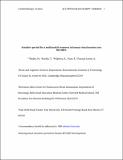| dc.contributor.author | Pelphrey, Kevin | |
| dc.contributor.author | Pascual-Leone, Alvaro | |
| dc.contributor.author | Bedny, Marina | |
| dc.contributor.author | Konkle, Talia A. | |
| dc.contributor.author | Saxe, Rebecca R. | |
| dc.date.accessioned | 2012-04-13T19:55:32Z | |
| dc.date.available | 2012-04-13T19:55:32Z | |
| dc.date.issued | 2010-10 | |
| dc.date.submitted | 2010-08 | |
| dc.identifier.issn | 0960-9822 | |
| dc.identifier.uri | http://hdl.handle.net/1721.1/70037 | |
| dc.description.abstract | The middle temporal complex (MT/MST) is a brain region specialized for the perception of motion in the visual modality [ [1], [2], [3] and [4]]. However, this specialization is modified by visual experience: after long-standing blindness, MT/MST responds to sound [5]. Recent evidence also suggests that the auditory response of MT/MST is selective for motion [ [6] and [7]]. The developmental time course of this plasticity is not known. To test for a sensitive period in MT/MST development, we used fMRI to compare MT/MST function in congenitally blind, late-blind, and sighted adults. MT/MST responded to sound in congenitally blind adults, but not in late-blind or sighted adults, and not in an individual who lost his vision between ages of 2 and 3 years. All blind adults had reduced functional connectivity between MT/MST and other visual regions. Functional connectivity was increased between MT/MST and lateral prefrontal areas in congenitally blind relative to sighted and late-blind adults. These data suggest that early blindness affects the function of feedback projections from prefrontal cortex to MT/MST. We conclude that there is a sensitive period for visual specialization in MT/MST. During typical development, early visual experience either maintains or creates a vision-dominated response. Once established, this response profile is not altered by long-standing blindness. | en_US |
| dc.description.sponsorship | David and Lucille Packard Foundation | en_US |
| dc.description.sponsorship | National Center for Research Resources: Harvard-Thorndike General Clinical Research Center at Beth Israel Deaconess Medical Center (NCRR MO1 RR01032) | en_US |
| dc.description.sponsorship | Harvard Clinical and Translational Science Center (UL1 RR025758) | en_US |
| dc.description.sponsorship | National Institutes of Health (U.S.) (grant K24 RR018875) | en_US |
| dc.description.sponsorship | National Institutes of Health (U.S.) (grant RO1-EY12091) | en_US |
| dc.language.iso | en_US | |
| dc.publisher | Elsevier Ltd. | en_US |
| dc.relation.isversionof | http://dx.doi.org/10.1016/j.cub.2010.09.044 | en_US |
| dc.rights | Creative Commons Attribution-Noncommercial-Share Alike 3.0 | en_US |
| dc.rights.uri | http://creativecommons.org/licenses/by-nc-sa/3.0/ | en_US |
| dc.source | Prof. Saxe | en_US |
| dc.title | Sensitive Period for a Multimodal Response in Human Visual Motion Area | en_US |
| dc.type | Article | en_US |
| dc.identifier.citation | Bedny, Marina et al. “Sensitive Period for a Multimodal Response in Human Visual Motion Area MT/MST.” Current Biology 20.21 (2010): 1900–1906. Web. 13 Apr. 2012. © 2010 Elsevier Ltd. | en_US |
| dc.contributor.department | Massachusetts Institute of Technology. Department of Brain and Cognitive Sciences | en_US |
| dc.contributor.approver | Saxe, Rebecca R. | |
| dc.contributor.mitauthor | Bedny, Marina | |
| dc.contributor.mitauthor | Konkle, Talia A. | |
| dc.contributor.mitauthor | Saxe, Rebecca R. | |
| dc.relation.journal | Current Biology | en_US |
| dc.eprint.version | Author's final manuscript | en_US |
| dc.type.uri | http://purl.org/eprint/type/JournalArticle | en_US |
| eprint.status | http://purl.org/eprint/status/PeerReviewed | en_US |
| dspace.orderedauthors | Bedny, Marina; Konkle, Talia; Pelphrey, Kevin; Saxe, Rebecca; Pascual-Leone, Alvaro | en |
| dc.identifier.orcid | https://orcid.org/0000-0003-2377-1791 | |
| mit.license | OPEN_ACCESS_POLICY | en_US |
| mit.metadata.status | Complete | |
